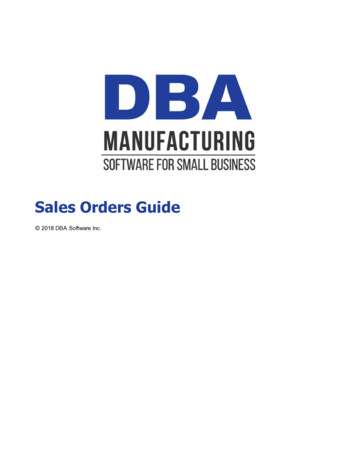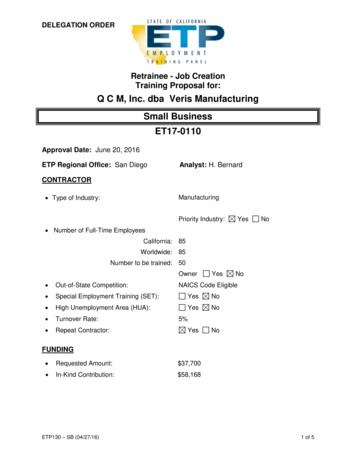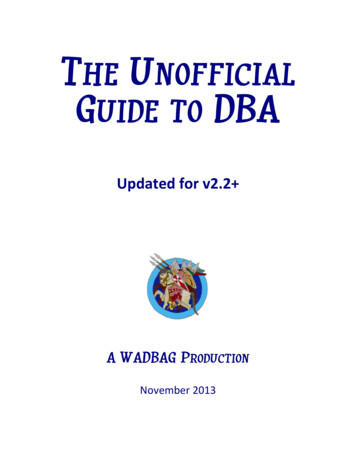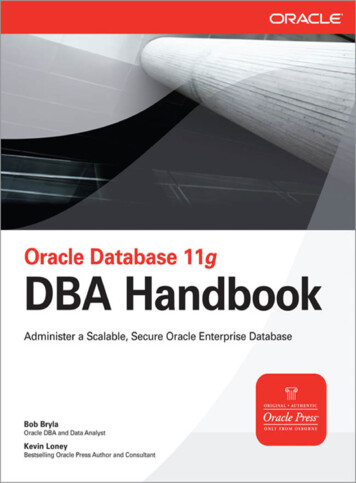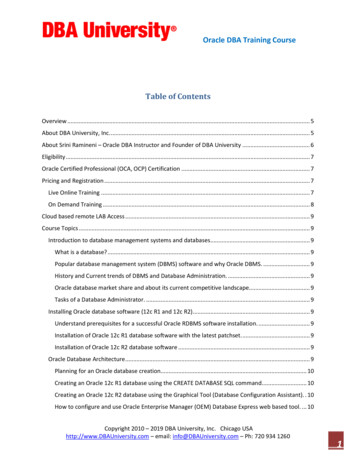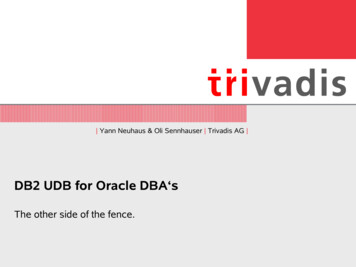
Transcription
Bill of Manufacturing Guide 2017 DBA Software Inc.
Bill of Manufacturing Guide 2017 DBA Software Inc.
Contents3Table of Contents1 Introduction42 Why You Need a Bill of Manufacturing63 Total Control Workflow84 Bill of Manufacturing Elements105 Stock Items126 Work Centers & Machines157 Subcontractors178 Standard Processes189 Product Structures (Subassemblies)2110 BOM Types2411 Revisions2612 Attaching Documents and Web Links2913 Routings3214 Components (Bill of Materials)3515 Outputs3816 Product Costing4017 Batch Manufacturing4118 Bill of Manufacturing Guidelines4319 FAQs44 2017 DBA Software Inc.3
41Bill of Manufacturing GuideIntroductionWhat does the bill of manufacturing do for you?The bill of manufacturing (BOM) stores item manufacturing specifications and providesthe following features and benefits:·Unlike a bill of materials, which is limited to components, the bill of manufacturingencompasses all manufacturing specifications, including revisions, routing,components, and outputs.·The bill of manufacturing fits almost any type of product, including standard items,subassemblies, batch type items, one-off custom items, byproducts, co-products,disassembled items, and remanufactured items.·The bill of manufacturing provides all the specifications needed to drive MRP andshop control.·Revisions provide engineering control and enable you to track specifications forcurrent, pending, and past product versions.·The routing lists all labor and subcontract service processes and associateddetails in sequential order and is the basis for product costing, work centerscheduling, labor tracking, and job subcontracting.·Multiple outputs accommodate byproducts, co-products, and disassembleditems and are ideal for disassembly and remanufacturing jobs.·Each BOM’s multi-level product structure is displayed in indented and tree viewformats.·You can attach documents, files, or web links to BOM parents for automaticlinking to jobs, which can be used for spec sheets, engineering drawings,images, safety data sheets, QC data collection sheets, training and safetycompliance videos, CAD drawings, and website links·Rapid BOM creation is facilitated by standard work center and subcontractorprocesses and the routing generator and speed entry functions.·BOM components can be imported from CAD programs and other sources.·The bill of manufacturing includes notes and task details within labor sequencesthat print on the shop traveler and provide process instructions out on the shopfloor.·Bills of manufacturing enable you to transfer process knowledge from keyproduction employees to your database so that it is preserved and protected andcan be accessed by anyone who needs it.·The bill of manufacturing provides extensive process documentation, augmentedwith the ability to attach documents to items for automatic linking to jobs, whichcan help you comply with ISO-9000 and other documentation requirements. 2017 DBA Software Inc.
Introduction5Our design is optimized for small businessWe’ve designed our bill of manufacturing so that it can be successfully used bycompanies of any size, especially small businesses, for these reasons:·Many small businesses make complex products and need BOM capabilities thatgo beyond the simple component lists provided by light manufacturing systems.·The bill of manufacturing drives our “Total Control” process workflow, whicheliminates all manual processes and is the easiest and most efficient way to runthe manufacturing side of your business, no matter how small it may be.Who is this guide for?This guide is for the benefit of managers, product engineers, production planners, andanyone who wants to learn how a bill of manufacturing works or is considering usingDBA as a manufacturing solution. 2017 DBA Software Inc.
62Bill of Manufacturing GuideWhy You Need a Bill of ManufacturingHow is a bill of manufacturing different than a bill of materials?Unlike a bill of materials, which is limited to a listing of the components that comprise anitem, the bill of manufacturing encompasses all manufacturing specifications, includingrevisions, the routing, components, and outputs.It goes beyond componentsThere is much more to a bill of manufacturing than a list of components. Revisionsprovide engineering control and enable you to track specifications for current, pending,and past product versions. The routing lists all labor and subcontract service processesand associated details in sequential order and is the basis for product costing, workcenter scheduling, labor tracking, and job subcontracting. Multiple outputsaccommodate byproducts and co-products and are ideal for disassembly andremanufacturing jobs.Can be used with virtually any productThe bill of manufacturing fits almost any type of product, including standard items,subassemblies, batch type items, one-off custom items, byproducts, co-products,disassembled items, and remanufactured items. It accommodates ultra-simple singlelevel items on up to highly complex multi-level product structures.Drives MRP and shop controlThe bill of manufacturing provides all the specifications needed to drive MRP and shopcontrol. MRP uses parent and component requirements to compare net demand withstock on hand to generate jobs and POs when needed. Routing cycle times are used tocalculate item Job Days settings that determine job start and finish dates in the masterschedule. Routings are the basis for job sequence scheduling within work centers outon the shop floor.Enables total control over all manufacturing processesWhen you operate solely with a bill of materials, you are using a “light manufacturing”system that is limited to inventory processes and forces you to use manual processes torun the shop. With a bill of manufacturing, however, you now have total control over allmanufacturing processes, including job release, work center scheduling, job labortracking, and subcontract service processing.Provides instructions to the shop floorThe bill of manufacturing enables you to define detailed notes and task details withineach labor sequence. This information prints on the shop traveler and provides processinstructions out on the shop floor, which improve quality and reduce errors. 2017 DBA Software Inc.
Why You Need a Bill of Manufacturing7Makes you less reliant on key employees for process knowledgeWhen process knowledge primarily resides with key employees, you are vulnerablewhen the one person who knows how to perform a critical process happens to be sick oron vacation or leaves the company. Bills of manufacturing enable you to transfer all thisknowledge to your database so that it is protected and can be accessed by anyone whoneeds it.Helps with ISO-9000 and other documentation requirementsThe bill of manufacturing provides extensive process documentation, augmented withthe ability to attach documents to items for automatic linking to jobs, which can help youcomply with ISO-9000 and other documentation requirements. 2017 DBA Software Inc.
83Bill of Manufacturing GuideTotal Control WorkflowThe Bill of Manufacturing is one of the eight phases that comprise DBA’s “Total Control”process workflow. This chapter provides an overview of the process workflow and howall eight phases contribute to your manufacturing efficiency.DBA is an integrated MRP and shop control systemDBA Manufacturing is an integrated MRP and shop control system. DBA replacesmanual planning and expediting with a coordinated master schedule and processworkflow that enables you to fulfill customer orders quickly and reliably using the leastamount of inventory and WIP possible.Most small businesses rely on manual planning and expeditingMost small businesses rely on manual planning where jobs and POs are created fromshortage reports using BOM explosions and job chaining, and shipping dates areguesstimated. To meet required dates, jobs get expedited at the expense of other jobsand precious time is squandered on investigating problems and putting out fires.DBA replaces manual planning and expediting with a master scheduleDBA replaces manual planning and expediting with a coordinated self-adjusting masterschedule for jobs, POs, and work centers that provides total control over your workflowprocesses. You always know when you can ship, when and what to make and buy, andwhat to do next out on the shop floor.The “Total Control” workflow executes the master scheduleDBA’s “Total Control” workflow is a set of standard processes that generates andexecutes the master schedule so that customer orders are fulfilled efficiently and ontime. The workflow progresses through eight phases:Phase 1 – Bill of ManufacturingThe bill of manufacturing (BOM) is used to define the work centers, subcontractors,processes, components, and outputs that comprise each of the items you make.The BOM provides the specifications needed for job generation.Phase 2 – Inventory ControlInventory control maintains the accuracy of on hand quantities that is absolutelyessential for MRP generation and job release. Accuracy is enhanced throughlocation control, lot and serial control, real time receipts, issues, and picking, andcycle counts.Phase 3 – Sales Orders 2017 DBA Software Inc.
Total Control Workflow9The ultimate purpose of the manufacturing system is to fulfill customer orders. Salesorders provide the top-level demand that drives MRP generation. Sales orders arealso used for order picking, shipping, and invoicing.Phase 4 – Custom ManufacturingCustom manufacturing uses quotes to generate one-off items for customizedproducts. One-off items and BOMs can be generated by copying and modifying amodel BOM or can be generated and entered from scratch. After BOM details arecompleted, quotes are converted to sales orders, which MRP uses to generatecustom jobs.Phase 5 – MRPMRP compares sales order demand with stock on hand and generates the masterjob and PO schedule based on item order policies. Items can be made orpurchased to order or to a target supply days based on a monthly forecast.Phase 6 – Shop ControlShop control is used to execute the master schedule. Jobs are released toproduction in the correct order of multi-level assembly based on material availability.Job sequences are assigned to workers in job priority order within work centers.Materials are issued to jobs in real time and job labor is updated as job sequencesare finished. Subcontract service POs are generated and received in real time asneeded. Finished items are received to stock and jobs are closed to complete thejob processing cycle.Phase 7 – Product CostingWIP-based product costing is used to calculate work center hourly rates for laborand manufacturing overhead. These rates get applied to standard and actual joblabor hours to calculate job costs for labor and overhead. Those job costs, alongwith material and subcontract service costs, are absorbed into the inventory cost offinished items to provide accurate inventory value and cost of goods sold.Phase 8 – Financial TransferThe financial transfer is used to transfer daily AR and AP vouchers to your financialaccounting system for receivables and payables processing. At period end, accounttotals are transferred to update your main general ledger to reflect the activities ofthe manufacturing system.Total control applies to any manufacturing companyManufacturing companies differ in the types of items they make, but the core processesthat comprise the “Total Control” workflow do not vary and can be applied universally toany manufacturing company or industry type. 2017 DBA Software Inc.
104Bill of Manufacturing GuideBill of Manufacturing ElementsThe bill of manufacturing (BOM) is comprised of the following elements, each of whichis described in detail over the next several chapters:Stock ItemsAll BOM parents and components are first defined as stock items in the Stock Itemsscreen.Work CentersWork centers are defined in the Work Centers screen and are used to organize theshop into work areas for job sequence scheduling. A work center can be a machine, aset of interchangeable machines, or an assembly area.SubcontractorsSubcontractors are defined in the Subcontractors screen and are used for subcontractservice processes such as plating, painting, and heat-treating.Standard ProcessesStandard processes can optionally be defined against work centers and subcontractorsto create a library of processes that enable rapid routing creation with consistent cycletimes and process documentation.BOM TypesBOM parents are defined on the List tab in the Bills of Manufacturing screen. BOMtypes include standard BOMs, batch type BOMs, one –off BOMs for custom items,secondary output BOMs, and phantom assembly BOMs.RevisionsRevisions provide engineering control and are defined on the Revisions tab in the Billsof Manufacturing screen. Each new version of a BOM parent can be given its ownrevision number. Complete BOM specifications are stored for current, pending, andarchived revisions.RoutingsRoutings are defined on the Routing tab in the Bills of Manufacturing screen. Eachrouting is a sequential list of the BOM parent’s labor and subcontract service processes.Each labor process is designated for a specific work center and includes setup andcycle times, traveler notes, and tasks. Each subcontract process includes PO notes, thesupplier price, and the number of days required to perform the service. 2017 DBA Software Inc.
Bill of Manufacturing Elements11ComponentsBOM components are defined on the Components tab in the Bills of Manufacturingscreen. Components can be subassemblies or purchase items. Each component isassigned to the routing sequence in which it is used.OutputsBOM outputs are defined on the Outputs tab in the Bills of Manufacturing screen. EachBOM has a primary output, which is the BOM parent, but can also have secondaryoutputs for byproducts, co-products, or disassembled items.Multi-Level ViewsThe Indented View and Tree View tabs in the Bills of
2017 DBA Software Inc. The ultimate purpose of the manufacturing system is to fulfill customer orders. Sales orders provide the top-level demand that drives MRP generation. Sales orders are also used for order picking, shipping, and invoicing. Phase 4 – Custom Manufacturing Custom manufacturing uses quotes to generate one-off items for customized



